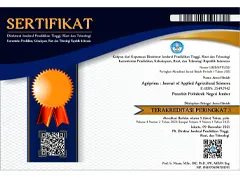Menilik Helopeltis spp. Hama Penting Komoditas Perkebunan di Indonesia
DOI:
10.25047/agriprima.v8i2.664Downloads
Abstract
Helopeltis spp. (Hemiptera), merupakan salah satu hama utama pada beberapa tanaman buah dan komoditas perkebunan. Di Indonesia, Helopeltis diketahui menyerang tanaman teh, kakao, kina, jambu mete, lada, dan hama minor pada tanaman kehutanan. Tidak hanya di Indonesia, Helopeltis juga telah menjadi hama utama pada berbagai komoditas lintas negara. Penurunan produksi secara signifikan akibat serangan hama ini menjadi alasan penting untuk pengendalian yang lebih akurat dan tepat sasaran. Tanaman yang terserang akan menunjukkan bercak coklat kehitaman dan mengering sehingga menyebabkan kuantitas dan kualitas produk menurun. Hama ini menjadi tantangan serius dalam perdagangan domestik dan luar negeri. Untuk keputusan pengelolaan yang lebih baik, sangat penting untuk mengetahui status hama, distribusi, kisaran inang, dan lain-lain. Hal ini berarti untuk pengendalian tersebut perlu adanya pengetahuan dasar mengenai Helopeltis itu sendiri. Teknik pengendalian utama yang masih digunakan oleh petani saat ini adalah aplikasi pestisida sintetik. Namun, seiring meningkatnya minat masyarakat terhadap produk yang ramah lingkungan dan aman terhadap kesehatan maka diperlukan alternatif pengendalian lainnya. Kajian jurnal ini membahas lebih dalam mengenai Helopeltis spp baik dari biologi, kelimpahan, perilaku makan, nilai ekonomi, interaksi dengan organisme lain, serta upaya pengendaliannya.
Keywords:
Helopeltis sp. pest pest controlReferences
Amanda, V. F., Yaherwandi, & Efendi, S. (2020). Kelimpahan Populasi Helopeltis sp. dan Tingkat Kerusakan Buah Kakao di Sitiung Kabupaten Dharmasraya. J. Ilmu-Ilmu Pertan.,14 (1), 33–46. Retrieved from DOI:10.31328/ja.v14i1.1275
Anggarawati, S. H., Santoso, T., & Anwar, R. (2017). Penggunaan Cendawan Entomopatogen Beauveria bassiana (BALSAMO) Vuillemin dan Lecanicillium lecanii (ZIMM) Zare & Gams untuk Mengendalikan Helopeltis antonii Sign (Hemiptera: Miridae). J. Silvikultur Tropika, 8 (3), 197 – 202. Retrieved from DOI:10.29244/j-siltrop.8.3.197-202
Asmara, D. T., Murti, R. H., Wijonarko, A., & Afifah, E. N. (2021). Evaluation of Resistant Tea (Camellia sinensis L.) Clones Against Helopeltis bradyii. J. of Agricultural Science, 43 (3), 518 – 525. Retrieved from DOI: http://doi.org/10.17503/agrivita.v43i3.2557
Bharathi, N. S., Mahendran, P., Antony, A., & Rabeesh, T. P. (2022). Behavioutal Response and mass Trapping of Males of Tea Mosquito Bug Helopeltis theivora Waterhouse. Indian Journal of Entomology, 84 (4), 778 – 782. Retrieved from DOI: 10.55446/IJE.2022.165
Borthakur, S., Bhuyan, M., Bhattacharyya, P. R., & Rao, P. G. (2011). Ultrasound: A Potential Tool for Management of Tea Mosquito bug, Helopeltis theivora Waterhouse (Miridae: Hemiptera). Science and Culture, 77 (11-12), 493 – 495. Retrieved from https://doi.org/10.54083/pha/1.2.2023/18-28
Damasia, D., Patel, Z.P, & Bambharolia, R. P. (2020). Effect of abiotic factors on seasonal incidence of tea mosquito bug, Helopeltis antonii Signoret of cashew in South Gujarat. Journal of Entomology and Zoology Studies, 8 (5), 695–698. Retrieved from https://www.researchgate.net/publication/346411735
EPPO, “Helopeltis Distribution,” EPPO Global Database, 2017. [Online]. Available: https://gd.eppo.int/search?k=helopeltis.
Firake, D. M., Sankarganesh, E., Yeshwanth, H. M., & Behere, G. T. (2020). Mirid bug, Helopeltis cinchonae Mann : a new pest of economically important horticultural crops in Northeast India. Phytoparasitica, 49 (1), 1-10. Retrieved from DOI:10.1007/s12600-020-00855-y
Haldhar, S. M., Berwal, M. K., Samadia, D. K., Kumar, R., Gora, J. S., & Choudhary, S. (2018). Biochemical Basis of Plant-insect Interaction in Arid Horticulture Crops: A Scientific Review. J. of Agriculture and Ecology, 6 (1), 1 – 16. Retrieved from http://journals.saaer.org.in/index.php/jae/article/view/156
Hazarika, L. K., Bhuyan, M., & Hazarika, B. N. (2009). Insect Pests of Tea and Their Management. Annual Review of Entomology, 54 (1), 267–284. Retrieved from DOI:10.1146/annurev.ento.53.103106.093359
Indriati, G. & Soesanthy, F. (2014). Hama Helopeltis spp. dan Teknik Pengendaliannya pada Pertanaman Teh (Camellia sinensis). SIRINOV, 2 (3), 189–198.
Kalshoeven, L. G. E., Pests of crops in Indonesia. Jakarta: PT. Ichtiar Baru, 1981.
Karmawati, E. (2010). Pengendalian Hama Helopeltis spp . pada Jambu Mete Berdasarkan Ekologi : Strategi dan Implementasi. Pengembangan Inovasi Pertanian, 3(2), 102–119. Retrieved from https://repository.pertanian.go.id/handle/123456789/17972
Karmawati, E. (2006). Peranan Faktor Lingkungan Terhadap Populasi Helopeltis spp. dan Sanurus indecora pada Jambu Mete. J. Littri, 12 (4), 129–135. Retrieved from https://api.semanticscholar.org/CorpusID:132889255
Melina, S., Martono, E., Trisyono, Y.A., Moechtar, S., & Radek, R. (2016). Morphology of adult Helopeltis bradyi ( Heteroptera : Miridae ) of Java , resolving a longstanding species uncertainty. North-Western Journal of Zoology, 12 (1), 110–121. Retrieved from https://api.semanticscholar.org/CorpusID:202736289
Radhakrishnan, B., & Srikumar, K. K. (2015). Pheromone traps, an efficient tool for the management of tea mosquito bug in tea. Planters Chronicle, 5 - 10. Retrieved from https://www.researchgate.net/publication/28232832
Ratnadass, A. & Jean-Philippe, D. (2020). Three-way interactions between crop plants, phytopathogenic fungi, and mirid bugs. A review. Agronomy for Sustainable Development, 40 (6), 1–14. Retrieved from DOI: 10.1007/s13593-020-00652-1
Roy, S., Muraleedharan, N., & Mukhapadhyay, A. (2015). The tea mosquito bug , Helopeltis theivora Waterhouse (Heteroptera : Miridae ): its status, biology, ecology and management in tea plantations. International Journal of Pest Management, 61 (3), 179–197. Retrieved from DOI:10.1080/09670874.2015.1030002
Saroj, P. L., Bhat, P. S., & Srikumar, K. K. (2016). Tea mosquito bug ( Helopeltis spp .) – A devastating pest of cashew plantations in India : A review, Indian J. Agric. Sci., 86, (2), 151–162. Retrieved from DOI:10.56093/ijas.v86i2.55868
Shah, S., Yadav, R., & Borua, P. (2014). Biochemical Defence Mechanism in Camellia sinensis Against Helopeltis theivora. Int. J. Plant, Anim. Environ. Sci., 4 (3), 246–253. Retrieved from https://api.semanticscholar.org/CorpusID:59065320
Siswanto, R. Muhamad, D. Omar, & Karmawati, E. (2008). Population Fluctuation of Helopeltis antonii Signoret on Cashew Anacarcium occidentalle L., in Java, Indonesia. Pertanika J. Trop. Agric. Sci, 31 (2), 191–196. Retrieved from https://api.semanticscholar.org/CorpusID:55433717
Supriyatdi, D., Lovantineya, D. R., & Utoyo, B. (2023). Potensi Ekstrak Serai Wangi dan Duan Mengkudu dalam Pengendalian Hama Penghisap Buah kakao (Helopeltis spp.). Jurnal Agrosains dan Teknologi, 8 (1), 11 - 20. Retrieved from DOI:10.24853/jat.8.1.11-19
Stonedahl, G. M. (1991). The Oriental species of Helopeltis (Heteroptera : Miridae) : a review of economic literature and guide to identification. Bulletin of Entomological Research, 81, 465–490. Retrieved from https://api.semanticscholar.org/CorpusID:86830073
Thube, S. H., Mahapatro, G. K., Mohan, C., Pandian R., T. P., Apshara, E. & Jose, C. T. (2019). Biology, feeding and oviposition preference of Helopeltis theivora, with notes on the differential distribution of species of the tea mosquito bug species complex across elevations. Animal Biology, 70 (1), 1–13. Retrieved from DOI:10.1163/15707563-20191083
Zed, M. (2003). Metode Penelitian Kepustakaan. Yayasan Obor Indonesia, Jakarta.
Pardede, H. F., Suryawati, E., Zilvan, V., Ramdan, A., Kusumo, R. B. S., Heryana, A., Yuwana, R. S., Krisnandi, D., Subekti, A., Fauziah, F., & Rahadi, V. P. (2020). Plant diseases detection with low resolution data using nested skip connections. Journal of Big Data, 7(1). Retrieved from https://doi.org/10.1186/s40537-020-00332-7
Sundari, L. (2023). Aplikasi Konsentrasi Ekstrak Daun Kipahit (Tithonia diversifolia (Hemslay) A. Gray) untuk Mengendalikan Intensitas Serangan Helopeltis bradyi Waterhouse Hama pada Tanaman Teh (Camellia sinensis (L.) Kuntze). Skripsi. Universitas Islam Nusantara.
License
Copyright (c) 2024 Gina Nur'aini Buchory, Iftita Fitri, Fani Fauziah (Author)

This work is licensed under a Creative Commons Attribution-ShareAlike 4.0 International License.
You are free to:
- Share — copy and redistribute the material in any medium or format.
- Adapt — remix, transform, and build upon the material for any purpose, even commercially.
Under the following terms:
- Attribution — You must give appropriate credit, provide a link to the license, and indicate if changes were made. You may do so in any reasonable manner, but not in any way that suggests the licensor endorses you or your use.
- ShareAlike — If you remix, transform, or build upon the material, you must distribute your contributions under the same license as the original.
- No additional restrictions — You may not apply legal terms or technological measures that legally restrict others from doing anything the license permits.









